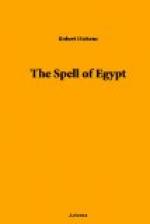Some people talk of the “sameness” of the Nile; and there is a lovely sameness of golden light, of delicious air, of people, and of scenery. For Egypt is, after all, mainly a great river with strips on each side of cultivated land, flat, green, not very varied. River, green plains, yellow plains, pink, brown, steel-grey, or pale-yellow mountains, wail of shadoof, wail of sakieh. Yes, I suppose there is a sameness, a sort of golden monotony, in this land pervaded with light and pervaded with sound. Always there is light around you, and you are bathing in it, and nearly always, if you are living, as I was, on the water, there is a multitude of mingling sounds floating, floating to your ears. As there are two lines of green land, two lines of mountains, following the course of the Nile; so are there two lines of voices that cease their calling and their singing only as you draw near to Nubia. For then, with the green land, they fade away, these miles upon miles of calling and singing brown men; and amber and ruddy sands creep downward to the Nile. And the air seems subtly changing, and the light perhaps growing a little harder. And you are aware of other regions unlike those you are leaving, more African, more savage, less suave, less like a dreaming. And especially the silence makes a great impression on you. But before you enter this silence, between the amber and ruddy walls that will lead you on to Nubia, and to the land of the crocodile, you have a visit to pay. For here, high up on a terrace, looking over a great bend of the river is Kom Ombos. And Kom Ombos is the temple of the crocodile god.
Sebek was one of the oldest and one of the most evil of the Egyptian gods. In the Fayum he was worshipped, as well as at Kom Ombos, and there, in the holy lake of his temple, were numbers of holy crocodiles, which Strabo tells us were decorated with jewels like pretty women. He did not get on with the other gods, and was sometimes confused with Set, who personified natural darkness, and who also was worshipped by the people about Kom Ombos.
I have spoken of the golden sameness of the Nile, but this sameness is broken by the variety of the temples. Here you have a striking instance of this variety. Edfu, only forty miles from Kom Ombos, the next temple which you visit, is the most perfect temple in Egypt. Kom Ombos is one of the most imperfect. Edfu is a divine house of “the Hidden One,” full of a sacred atmosphere. Kom Ombos is the house of crocodiles. In ancient days the inhabitants of Edfu abhorred, above everything, crocodiles and their worshippers. And here at Kom Ombos the crocodile was adored. You are in a different atmosphere.
As soon as you land, you are greeted with crocodiles, though fortunately not by them. A heap of their black mummies is shown to you reposing in a sort of tomb or shrine open at one end to the air. By these mummies the new note is loudly struck. The crocodiles have carried you in an instant from that which is pervadingly general to that which is narrowly particular; from the purely noble, which seems to belong to all time, to the entirely barbaric, which belongs only to times outworn. It is difficult to feel as if one had anything in common with men who seriously worshipped crocodiles, had priests to feed them, and decorated their scaly necks with jewels.




